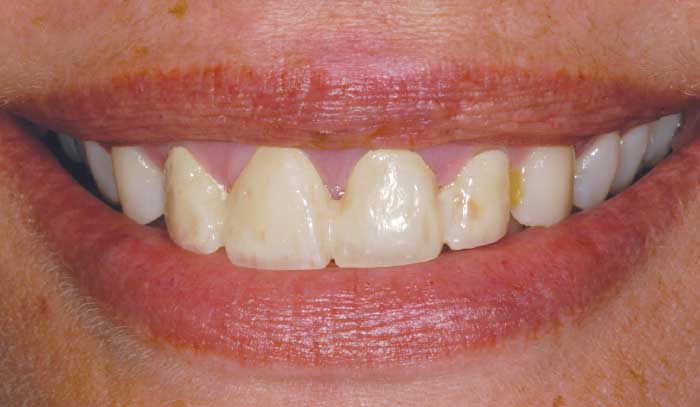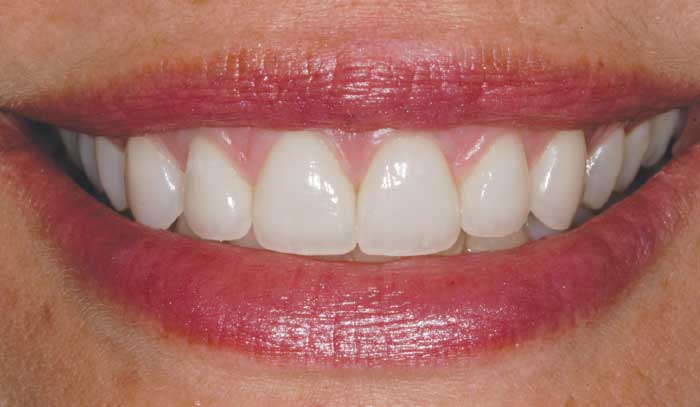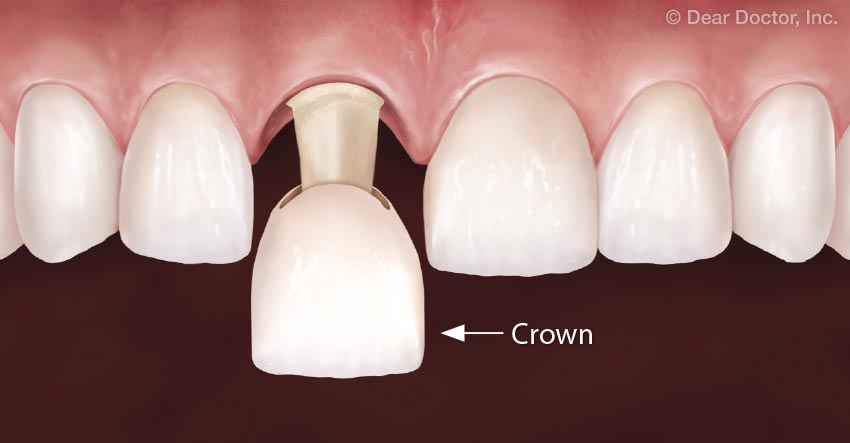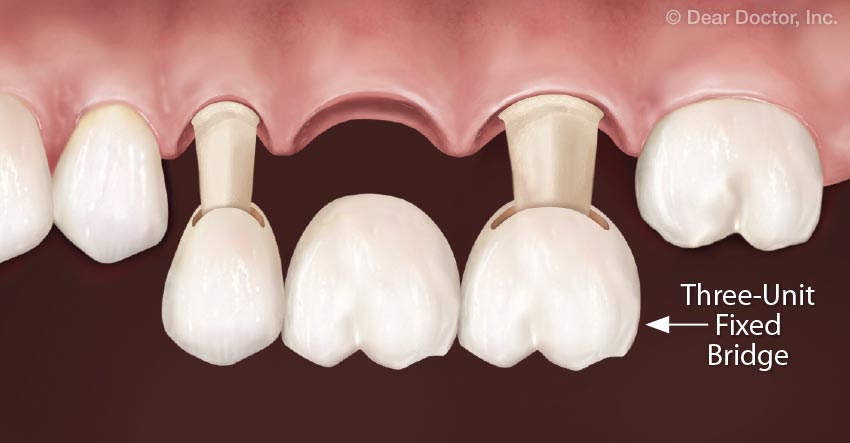Extending the Life of Your Dental Work
How to get the most out of fillings, veneers, crowns and bridges
 |
In recent years, dentistry has seen an ever-increasing use of high-tech tools and techniques. The restorative materials dentists use today work better and hold up longer than ever before. Yet it's still not possible to guarantee that any dental restoration will last forever. Why not?
To answer that question, first think about what your fillings, veneers or crowns are being asked to do: Dental restorations exist in an environment filled with disease-causing bacteria and erosive acids, and are routinely subjected to biting forces measuring over 100 pounds per square inch. When viewed that way, it's a wonder dental work holds up at all!
Still, there are various factors that affect the longevity of dental work—some of which we can control and some we can't. Let's examine the most common dental restorations and look at ways you can help them last as long as possible.
Fillings
Fillings are needed when your tooth develops a cavity, which is a hole in the protective enamel coating. Cavities are caused by harmful oral bacteria, but the decay process can be accelerated by a diet high in sugar and acid (soda, for example, has both). Treating a cavity involves removing the decayed area and then filling the hole with either an amalgam ("silver") filling, tooth-colored resin-based material or milled porcelain.While it used to be that silver fillings held up better than more natural-looking ones, today's tooth-colored materials are very durable. However, placing a tooth-colored filling is a more delicate process that requires extra attention to detail. For example, the area being filled must be kept completely dry during the process to create a good seal.
Any dental restoration is most vulnerable to breaking down at the point where it meets the tooth. If filling and tooth separate even a tiny bit, bacteria can get in and start the decay process all over again. When this happens, the filling must be replaced. This is more of an issue with larger fillings, which expand and contract more than smaller ones.
To help your fillings last as long as possible, develop a good daily oral hygiene routine to reduce disease-causing bacteria with daily brushing and flossing, and try to cut down on sugar in your diet. I have seen some of my own patients give up sugar completely, and it's truly amazing how much healthier their mouths become.
Also, keep in mind that tooth-colored fillings can absorb stain, particularly from beverages like wine, cola, coffee and tea. Some people opt to replace a stained filling simply to make their smile look better—even if it is otherwise still doing its job. If you notice that a tooth-colored filling is starting to discolor, consider reducing your intake of dark-colored drinks.
Veneers
Veneers can give worn, discolored teeth a bright new look. They are thin, tooth-colored shells, usually made of dental porcelain, that cover the front surface of the tooth (the side that's visible when you smile). A major advantage of dental porcelain is that it doesn't stain like a tooth-colored filling. Dentists can choose from a variety of porcelains, some known for durability and others for how well they can blend with natural teeth.
| Photos provided by Elizabeth M. Bakeman, DDS |
 |
| Before Veneers |
 |
| After Veneers |
The bond between veneer and tooth is very strong, but habits such as nail-biting and ice-chewing can cause a veneer to chip. Teeth-grinding can also be a big problem when it comes to making veneers hold up over time. The risk of grinding, also called bruxism, can sometimes be minimized (but not necessarily eliminated) by making sure the bite is as even as possible—with no tooth protruding above the others even slightly.
It is also essential for anyone with veneers who routinely grinds their teeth to wear a custom-made acrylic nightguard. This prevents the teeth from rubbing together during sleep, and can appreciably extend the life of the veneers.
Gum recession is another risk you need to guard against when you have veneers. Shrinking gum tissue can expose a tooth's roots, which are almost always noticeably darker (more yellow) than the veneer. This contrast is not cosmetically appealing and sometimes requires that the veneer be replaced or the tooth root bonded (covered with tooth-colored material). Keeping the gums healthy and free of dental plaque is a great way to help minimize this.
If you are a severe bruxer, or you are very susceptible to gum disease or tooth decay, your dentist might recommend an alternative to veneers. A dental crown, which covers the entire tooth instead of just the front surface, might be more appropriate.
Crowns and Bridgework
 |
| A crown can restore a severely decayed or damaged tooth. A significant amount of enamel must be removed from the tooth to fit the crown over it. |
 |
| A three-unit fixed bridge is cemented onto the adjacent teeth to replace the missing tooth in between. |
 |
| When a dental implant is used to replace a missing tooth, there is no need to file down the teeth on either side. |
Crowns (or caps) are used in many ways. They can restore individual teeth that have suffered major decay or trauma; they can even replace missing teeth as part of a fixed (non-removable) dental bridge.
A three-unit bridge is a common type of restoration used to replace a single missing tooth. It consists of three dental crowns attached together in a row. For this method to work, there must be a healthy tooth on either side of the gap left by the missing tooth. The first and third crowns in the bridge fit over these healthy teeth, which must be shaped for use as supports. The middle crown (referred to as a "pontic") serves as the substitute for the missing tooth.
Bridgework that's well constructed looks very realistic and can hold up for many years. But turning those two healthy teeth on either side of the gap into bridge supports makes them more vulnerable to decay. That's because a significant amount of tooth enamel must be removed to fit the crowns over them; and enamel is what protects a tooth from decay.
When I am replacing a tooth that has healthy teeth on either side with no fillings, I much prefer using a dental implant to a three-unit bridge. That way, I am not potentially reducing the lifespan of those healthy teeth. In either case, meticulous oral hygiene at home and regular professional dental cleanings will promote the longevity of your tooth replacement.
Helping Dental Treatment Last
Perhaps you are noticing a theme here: Good oral hygiene has a lot to do with how well your dental work will hold up—and your natural teeth too, for that matter. Other factors include: your susceptibility to tooth decay and gum disease; your diet; and oral habits like teeth grinding. To summarize, here are my best tips for getting the longest life out of your dental work:
- Develop a good daily oral hygiene routine at home that includes brushing twice each day with fluoride toothpaste and flossing (or using another dental device to clean between the teeth) at least once a day. Pay special attention to all areas where a filling, veneer or crown meets the gum line.
- Rid your diet of sugar to the extent possible, and be aware of how frequency of sugar consumption affects your risk. Damage to dental work (and natural teeth!) can be much greater in someone who sucks on hard candy or sips soft drinks throughout the day. Avoid beverages that stain if you have tooth-colored dental work that is not made of porcelain.
- See your dentist regularly for professional cleanings and exams. Also call your dentist if you experience any pain or increased sensitivity in a tooth that has been filled or capped. Early intervention can often extend the life of dental work when a problem is still small.
- If you grind your teeth at night, have a night guard made and use it!
- Choose a skilled dentist who keeps abreast of the latest materials and techniques. This can be demonstrated with continuing education courses and active memberships in professional organizations.
Dental materials have come a long way in the new millennium. With regular visits to your dentist and attention to your oral health at home, your smile can look great for many years to come.





